Do you use LinkedIn ads? Wondering if you're making costly mistakes?
In this article, you'll discover four LinkedIn advertising mistakes and learn how to avoid them.
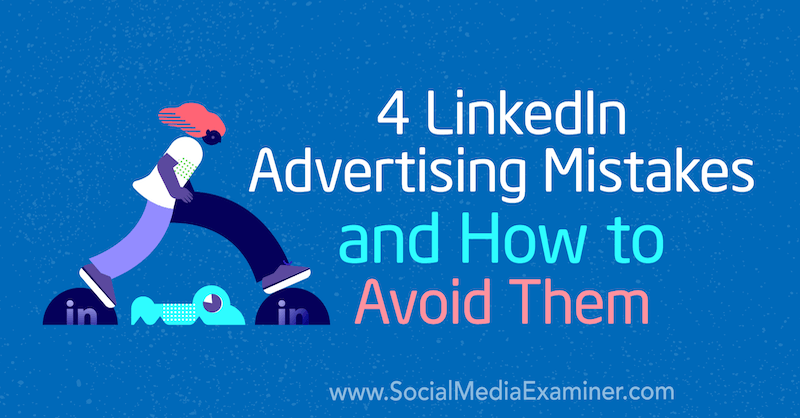
Why Use LinkedIn Ads?
In the past, reaching people with your messaging on LinkedIn was almost easy. Compared to quickly growing platforms such as Facebook, the LinkedIn feed was uncluttered. However, as other platforms have become saturated with organic and paid posts from businesses, more and more marketers are looking toward LinkedIn to reach customers and consumers.
LinkedIn advertising gives those marketers and business owners a way to put their messaging in front of the people and decision makers who are most likely to sign on as customers. That said, all advertising has its learning curve. Whether you're just beginning to use LinkedIn ads or you've ran a number of campaigns, the following tips will help you get better results from your LinkedIn ad spend.
#1: Applying Ineffective LinkedIn Ad Targeting Tactics
One of the biggest draws for advertisers on LinkedIn is the unique targeting options; in particular, those related to work. Company Names, Company Industries, Company Size, Job Functions, Job Titles, Member Skills, and Interests are all categories available to marketers on the platform.
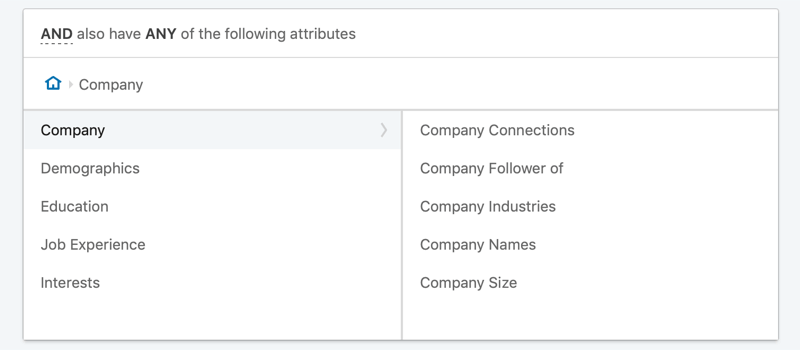
With so many targeting criteria, it's easy to make the mistake of over-targeting your ads when you create an audience on LinkedIn. The platform simply doesn't have as many users as competitors like Facebook. This means you'll need to keep an eye on your target audience size because the number can shrink quickly as you add more targeting criteria.
If your audience gets too small, your results are all but certain to be suboptimal, no matter what your goals are. A small audience provides fewer opportunities for impressions, clicks, leads, and sales. Don't fall into this trap.
To avoid this mistake, first make sure you understand what narrows an audience and what expands it. When you make multiple selections within a category, your LinkedIn ads will target all of your selections, making your audience larger.
For example, if you select Accounting and Finance in the Job Functions category, your ads will target users who have job functions in either accounting or finance.
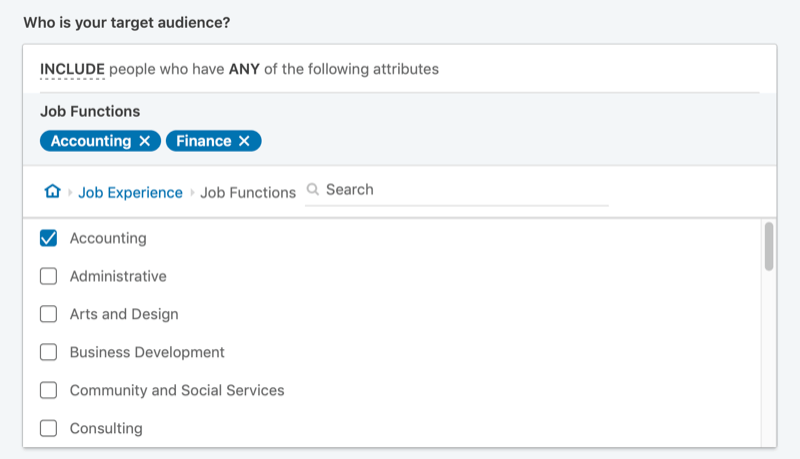
On the flip side, when you select multiple categories like Job Functions and Job Seniorities, you'll be showing your ads only to users who match both of your selected categories.
Building on the previous example, if you were to also target Job Seniorities of VP and Director, your ads would now only be showing to VPs and directors whose job functions are related to Accounting or Finance. Your audience in this scenario would be much smaller.
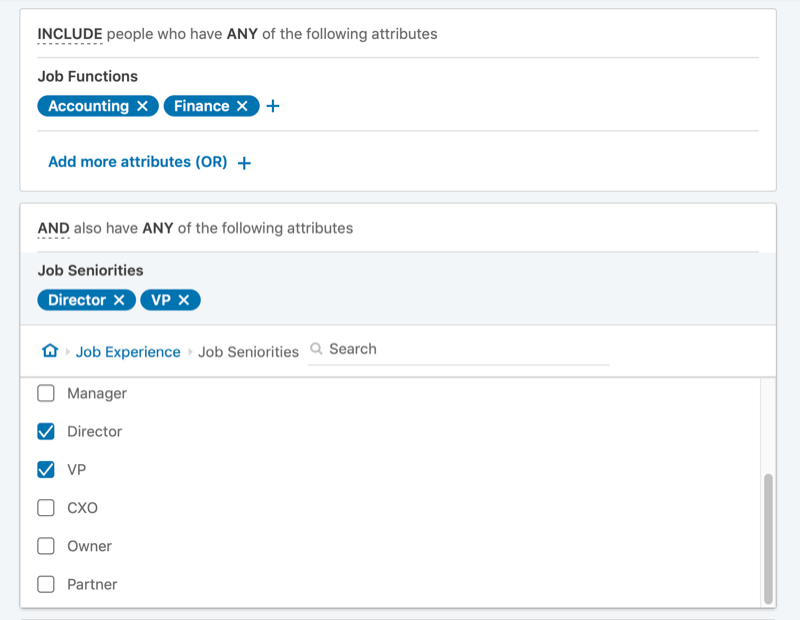
Get World-Class Marketing Training — All Year Long!
Are you facing doubt, uncertainty, or overwhelm? The Social Media Marketing Society can help.
Each month, you’ll receive training from trusted marketing experts, covering everything from AI to organic social marketing. When you join, you’ll also get immediate access to:
- A library of 100+ marketing trainings
- A community of like-minded marketers
- Monthly online community meetups
- Relevant news and trends updates
When you're setting up ads, keep a close eye on the estimated audience count in the top-right corner of LinkedIn Campaign Manager. This number doesn't reflect how many people your ad will reach, but it does tell you how many LinkedIn members match your targeting criteria overall.
Although you can launch campaigns that target as few as 1,000 members, I recommend trying to keep your audience larger than 100,000 members for optimum scale. Never go below a target audience size of 50,000 or you'll risk too few people seeing your ads, which leads to ad fatigue and poor results.
To help you keep your audience size large, follow the 2+1 rule: Create an audience with no more than two categories plus the Location field. Choose as many subcategories as you want because this broadens your audience but keep the overall categories at two whenever possible.
Many advertisers begin testing the waters with a combination of Job Functions and Job Seniorities, Company Industries and Company Size, or Job Functions and Member Skills. These are all great audiences that will ensure you reach enough LinkedIn members.
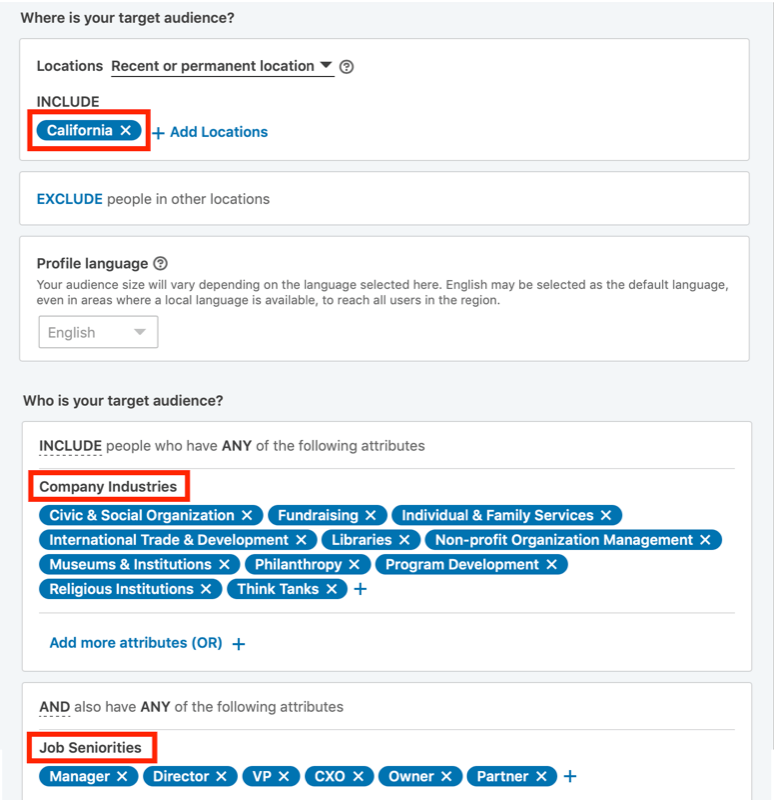
#2: Underutilizing LinkedIn Matched Audiences
There are three types of matched audiences on LinkedIn that can take your advertising campaigns to a new level: website retargeting, email contact targeting, and account targeting.
LinkedIn has great custom targeting options so advertisers often overlook these three types of campaigns, which is a huge mistake. Providing LinkedIn with data you collect on your customers is crucial to your success and can drive more results at a fraction of the price.
Website Retargeting
If you already have interested prospects on your email list or visiting your website, put your initial energy into creating ads specifically for those audiences. You're most likely to get traction there.
With a LinkedIn website retargeting campaign, you can advertise to people who visit your site and ensure you're not missing any low-hanging fruit. These individuals have already expressed an interest in your company just by visiting your website so setting up an audience to target them should be a top priority.
You'll need to add the LinkedIn insight tag (a unique JavaScript code in your LinkedIn account) to your website's global footer and give the tag some time to build. Depending on how much traffic your website receives, you should have a large enough audience to advertise to within a matter of days.
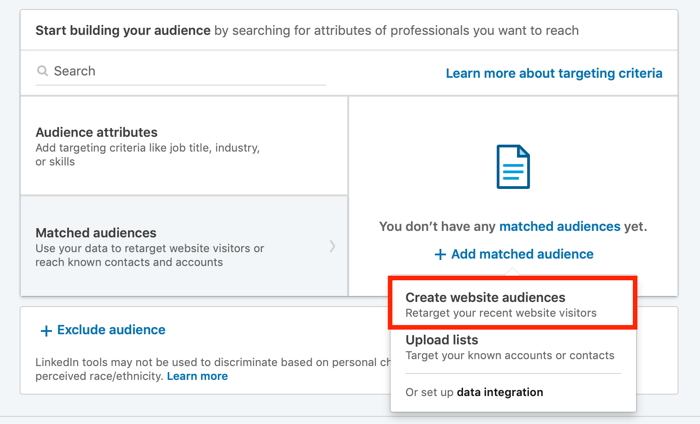
Email Contact Targeting
Email contact targeting is another popular advertising feature that shouldn't be overlooked. It allows advertisers to upload contact lists to LinkedIn and run ads that target users who match those emails.

Discover Proven Marketing Strategies and Tips
Want to go even deeper with your marketing? Check out the Social Media Marketing Podcast! Publishing weekly since 2012, the Social Media Marketing Podcast helps you navigate the constantly changing marketing jungle, with expert interviews from marketing pros.
But don’t let the name fool you. This show is about a lot more than just social media marketing. With over 600 episodes and millions of downloads each year, this show has been a trusted source for marketers for well over a decade.
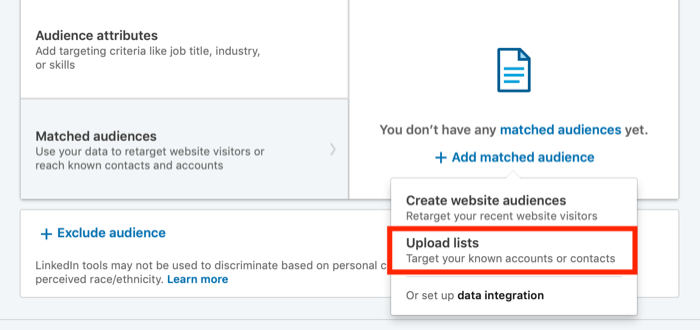
For contact lists, all you need is a list of at least 300 email addresses that match LinkedIn members. That being said, LinkedIn recommends that you run campaigns that target a minimum of 10,000 individuals so try to submit more than the bare minimum. You want to give your campaign the best possible chance for success, and to do that you'll need a wider audience than just a few hundred people.
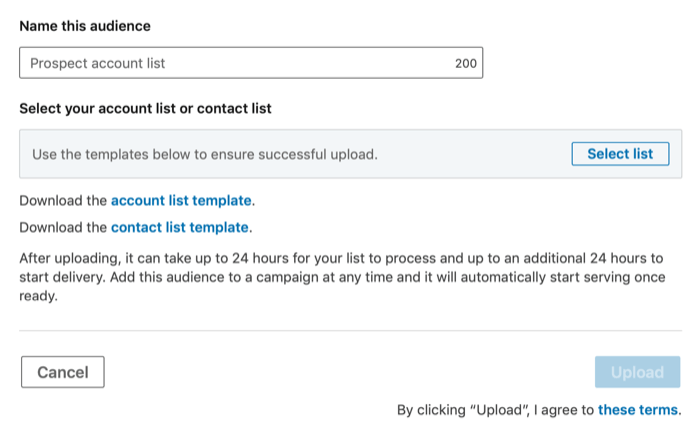
Account Targeting
The third type of matched audience campaign is account targeting. This is a feature unique to LinkedIn that lets you submit a list of company names and websites, and advertise to people who work at those specific places.
For these audiences, it's recommended that you submit at least 1,000 companies to ensure your audience will be large enough to target on LinkedIn.
Remember, when running campaigns targeting matched audiences, the 2+1 rule no longer applies. Because your audiences will likely already be on the smaller side, any further targeting criteria should be as minimal as possible (especially if you're working near the minimum recommended audience sizes). One additional targeting criterion is the maximum layer to add to any matched audience campaign.
If you're really looking to optimize for results, comb through your contact list and create a new list with only decision-makers.
#3: Underfunding LinkedIn Advertising Campaign Budgets
If you're familiar with Google or Facebook advertising and just diving into LinkedIn's marketing solutions, you might be surprised to learn that LinkedIn requires a minimum spend of $10 per day per campaign, a sharp increase from the competition.
In cases where hitting this minimum spend is a challenge, you should explore other options. LinkedIn ads are extremely effective, but they're by no means the cheapest digital advertising platform. Consider other options if $10 per day sounds steep.
To avoid spreading campaigns too thin on LinkedIn, try allocating the majority of your budget to one campaign at a time. Give your campaign the chance to succeed with more dollars and more impressions, and then use LinkedIn's Website Demographics reporting to analyze your campaign's successes and failures.
Make adjustments based on the data found both in Website Demographics and on the Campaign Performance tab. You can access both in Campaign Manager.

When analyzing your website demographics, pay close attention to the targeting criteria you selected and which subcategories are giving you the most results. Remove targeting criteria that don't serve your goals and test new groups in your next campaign. This keeps your budget down and ensures you're constantly optimizing.
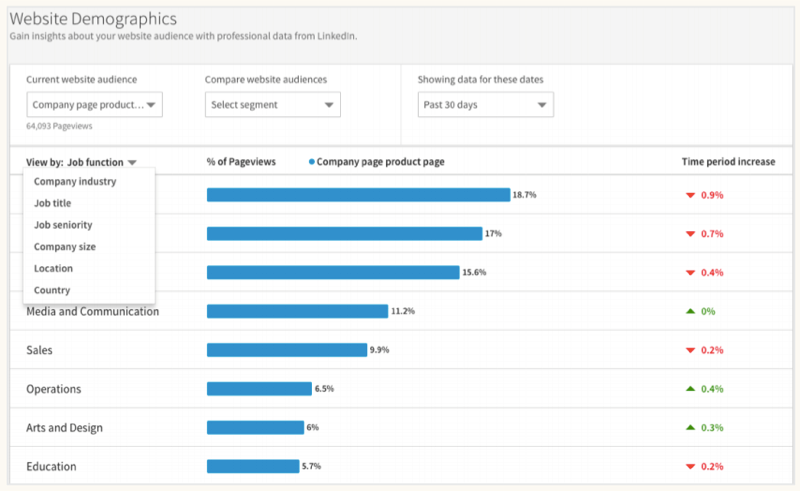
The same is true for campaign performance. Analyze the data and watch your cost per thousand impressions (CPM) and click-through rate (CTR). The former will tell you whether your audience is too small and the latter will speak to your ad itself.
#4: Using Only One LinkedIn Ad Placement per Campaign
There are three main types of LinkedIn placements you can run: sponsored content, sponsored InMail, and text ads. Sponsored InMail ads are messages that run within LinkedIn Messaging and text ads run in the right-hand sidebar of the site on desktop.
While all of these placements can provide great results, most advertisers focus on sponsored content as their placement of choice, and like all forms of display ads, your images are crucial.
The high budgetary requirements on LinkedIn can often force advertisers into creating just one campaign, but this shouldn't limit your number of ads. Campaigns with a $10 per day budget can still run multiple ads so don't make the mistake of limiting your creatives.
Create a minimum of four ads per campaign with different imagery and designs. You can even test video and carousel ads to see which performs best with your target audience.
Don't limit yourself; the goal is to try as many quality ads as possible and make decisions based on the data you find on the Website Demographics and Campaign Performance tabs. It will be very evident which ads perform best after you look at the numbers. From there, you can tailor your campaigns to feel more like your top-performing ads and less like your weakest performers.
You'll also want to test different combinations of ad copy. When you create a new ad in a campaign, you'll be able to add introductory text to sponsored content. This text can act as a call to action, a description for your product or service, or simply a way to grab the user's attention. Test combinations of text with ads and see what stands out.
Conclusion
Creating LinkedIn ads can be challenging but learning some of the most common mistakes and how to avoid them will give you a leg up on the competition. LinkedIn's advertising platform is getting better all the time so it's important to stay up to date on changes to make sure your campaigns are fully optimized.
What do you think? Do you use LinkedIn ads for your business? Which of the campaign objectives do you find the most successful for your company? Please share your thoughts and tips in the comments.
More articles on LinkedIn marketing:
- Learn how to develop a LinkedIn page content strategy.
- Discover how to create objective-based ads using LinkedIn's Campaign Manager.
- Find out how to use four LinkedIn marketing features to nurture leads.
Attention Agency Owners, Brand Marketers, and Consultants

Introducing the Marketing Agency Show–our newest podcast designed to explore the struggles of agency marketers.
Join show host and agency owner, Brooke Sellas, as she interviews agency marketers and digs deep into their biggest challenges. Explore topics like navigating rough economic times, leveraging AI, service diversification, client acquisition, and much more.
Just pull up your favorite podcast app, search for Marketing Agency Show and start listening. Or click the button below for more information.

